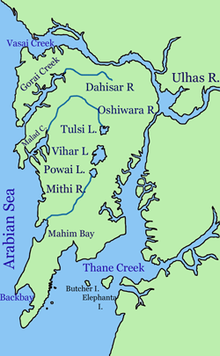Disease outbreak feared after mass hysteria over "sweet" water in Mumbai
Wednesday, August 23, 2006

"18 hours of mass hysteria" (according to the Sunday Times of India) broke out last Friday in Mumbai as hundreds of residents flocked to Mahim Creek, one of the most polluted creeks in India that receives thousands of tonnes of raw sewage and industrial waste every day after reports that the salt water had suddenly turned "sweet".
Television reports showed people drinking water on the spot with their hands, and others bathing, apparently to wash away their sins with the "holy" water.
At the height of the hysteria, bottled mineral water was selling for Rs 50 (RM4.50), with people buying the mineral water simply for the bottles, pouring away the mineral water and filling the bottles with water from the creek.
News reports of the Mahim Creek incident sparked further mass hysteria at Gujarat within hours, with residents there claiming that seawater at Teethal beach in Valsad had also turned sweet. About 400 people had gathered by the beach in the evening.
In the aftermath of the incident, local authorities stated that they were being were extra vigilant because of the possibility of a severe outbreak of water-borne diseases, such as gastroenteritis as a result of so many people drinking contaminated water. The Maharashtra Pollution Control Board had warned people not to drink the water, but despite this many people had collected it in bottles, even as plastic and rubbish had drifted by on the current. The Municipal Corporation of Greater Mumbai had ordered a bacteriological report into the "sweet" water, but suspected that "contamination in the water might have been reduced due to the waters from Mithi River flowing into the mouth of Mahim Bay".
By Saturday morning, the hysteria had died down, as the taste of the water had returned to normal.
Why the water turned sweet
[edit]Geologists at the Indian Institute of Technology in Bombay and M.D. Zingde, the head of the Mumbai office of the National Institute of Oceanography explained that the water turning sweet in Mahim Creek was a natural phenomenon. Continuous rainfall over the preceding few days had caused a large pool of fresh water to accrue in an underground rock formation near to the coast, which then discharged into the sea as a large "plume" as fractures in the rocks widened. Because of the differences in density, the discharged fresh water floated on top of the salt water of the sea and spread along the coast. Over time, the two mixed to become normal sea water once more.
A similar explanation for the phenomenon in Gujarat was given by Valsad District Collector D Rawal. According to him, the reason for the water tasting less salty than usual was that because of the monsoon, two rivers Auranga and Banki were in spate and had been flowing into the sea in the region.
Sources
[edit]- "Authorities fear "sweet" water could cause diseases" — The Hindu, August 20, 2006
- "IIT geologists say Mahim miracle a natural phenomenon" — The Hindu, August 20, 2006
- "Mumbai's "Sweet" Sea Water Sparks Mass Hysteria" — Bernama, August 20, 2006
- Rathin Das. "Sweet water miracle in Gujarat too" — Hindustan Times, August 19, 2006
- "People taste "sweet" sea water in Mumbai" — The Times of India, August 19, 2006
- "Hundreds drink "sweet seawater"" — BBC News Online, August 19, 2006
| |
This page has been automatically archived by a robot, and is no longer publicly editable.
Got a correction? Add the template {{editprotected}} to the talk page along with your corrections, and it will be brought to the attention of the administrators. Please note that the listed sources may no longer be available online. |

